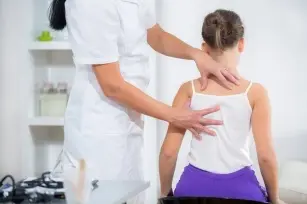
Posture defects are a condition that affects a large part of the human population today. They are favored by a sedentary lifestyle, spending a lot of time in front of the TV, at the computer, lack of sports and low physical activity. Specialists are sounding the alarm because children and teenagers now prefer to spend long hours on social networking sites than meeting friends in real life.
It is worth taking care of prevention in advance, because the treatment of posture defects is a tedious and long-term process. It requires a lot of determination and a lot of work and patience from the patient.
What is scoliosis?
Scoliosis This is one of the most common posture defects. It is also called lateral curvature of the spine, which is a simplification. In fact, the disease consists in curvature of the spine greater than 10° not only in the lateral (frontal) plane, i.e. to the right or left, but also in the sagittal and horizontal (transverse) planes. Visually, the spine then has an S-shaped shape. Usually, scoliosis affects the upper or middle part of the back. It can manifest itself from the moment the child begins to walk, during the period of bone growth, and is often exacerbated during puberty, when the growth of height is very rapid. This is due to the fact that the muscles do not keep up with the development of the skeleton and do not provide sufficient support for the spine. Girls are more likely to suffer from scoliosis than boys, and the earlier it appears, the greater the risk.
What are the symptoms of the disease?
Factors visible to the naked eye include:
- bending the spine to the side, most noticeable when bending forward,
- protruding shoulder blades,
- hump on one side of the back,
- shoulders and hips at different heights,
- more pronounced waistline on one side,
- uneven legs, one longer than the other,
- retraction of one of the breasts in girls.
So if you see any of the above in your child, and he’s having a hard time buying clothes that fit well, and his spine looks crooked when he tries to stay straight, he may have scoliosis.
Diagnosis and treatment
The initial diagnosis is made by the parent himself. Irregularities may also be suggested by a general practitioner or school hygienist. Assumptions should be consulted in an orthopedic clinic. There, the doctor will also conduct an examination based on the examination of the back, and to be sure, he should order an imaging test. Most often it is an X-ray, less often a tomography or an MRI. Treatment may consist in rehabilitation, corrective gymnastics classes, sometimes a special orthopedic corset is needed, or stiffening the body with a plaster cast, apparatus or traction. In extreme cases, it is necessary to undergo surgery involving the implantation of metal braces or implants.









